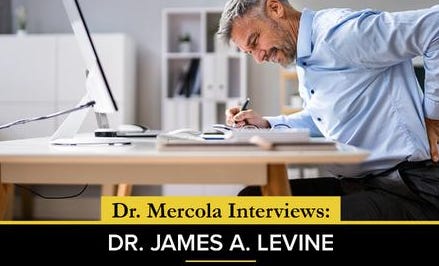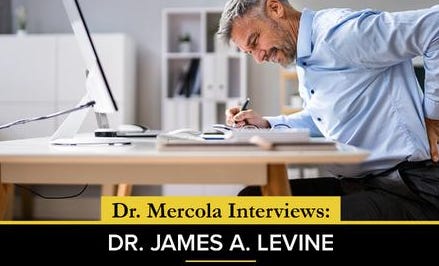Take a Stand: The Dangers of Prolonged Sitting
Interestingly, evidence of the biological effects associated with lack of movement go further back than you might think
Evidence shows that prolonged sitting is devastating your health. In his book, “Get Up!: Why Your Chair Is Killing You and What You Can Do About It,” Dr. James Levine, co-director of the Mayo Clinic and the Arizona State University Obesity Initiative, notes there are about 10,000 publications showing that sitting is harmful to your health.
Prolonged sitting actively promotes dozens of chronic diseases, including obesity and Type 2 diabetes, even if you’re very fit and exercise regularly. It’s also an independent risk factor for premature death, even if you lead an otherwise healthy lifestyle. In fact, chronic sitting has a mortality rate similar to smoking.1
Studies looking at life in agriculture environments show that people in agrarian villages sit for about three hours a day. Meanwhile, the average American office worker can sit for 13 to 15 hours a day, and research shows that vigorous exercise cannot counteract the adverse effects of this prolonged sitting.
Abandoning Nomadic Lifestyle Made Man’s Bones Less Dense
Interestingly, evidence of the biological effects associated with lack of movement go further back than you might think — straight into the human fossil records, as reported by NPR in 2014 (audio above).
According to biological anthropologists at the Smithsonian National Museum of Natural History, the fossil record suggests that when early man traded their nomadic hunter-gatherer lifestyles for a more settled one, it resulted in a less dense bone structure. As reported by NPR:2
“The lightweight bones don’t appear until about 12,000 years ago. That’s right when humans were becoming less physically active because they were leaving their nomadic hunter-gatherer life behind and settling down to pursue agriculture.
A report on the work appeared … in the Proceedings of the National Academy of Sciences,3 along with a study from a different research group that came to much the same conclusion.
Those researchers looked at the bones of people in more recent history who lived in farming villages nearly 1,000 years ago and compared them with the bones of people who had lived nearby, earlier, as foragers.
‘We see a similar shift, and we attribute it to lack of mobility and more sedentary populations,’ says Timothy Ryan, an associate professor of anthropology at Penn State University. ‘Definitely physical activity and mobility is a critical component in building strong bones.’”
Prolonged Sitting Takes a Toll Even if You Exercise
The health effects go far beyond reductions in bone density, however. I for one am absolutely convinced that excessive sitting is a foundational contributor to most chronic health problems and premature death, and research supports this notion. For example, as noted in a 2010 paper in Exercise and Sport Sciences Reviews:4
“Even when adults meet physical activity guidelines, sitting for prolonged periods can compromise metabolic health. Television (TV) time and objective measurement studies show deleterious associations, and breaking up sedentary time is beneficial. Sitting time, TV time, and time sitting in automobiles increase premature mortality risk …
Physiologically, it has been suggested that the loss of local contractile stimulation induced through sitting leads to both the suppression of skeletal muscle lipoprotein lipase (LPL) activity (which is necessary for triglyceride uptake and high-density lipoprotein (HDL) cholesterol production) and reduced glucose uptake …
[T]he perspective that we propose is that too much sitting is distinct from too little exercise … [I]nitial findings on the metabolic correlates of prolonged TV viewing time have since been confirmed by recent objective measurement studies, which also show that breaking up sedentary time can be beneficial …
Importantly, adults can meet public health guidelines on physical activity, but if they sit for prolonged periods, their metabolic health is compromised … [T]here is … the potential for high sedentary time and physical activity to coexist …
An example would be an office worker who jogs or bikes to and from work, but who then sits all day at a desk and spends several hours watching TV in the evening.”
In short, while sitting is clearly a sedentary behavior, standing is not. The authors cite several studies5 showing that prolonged sitting promotes the very ailments that modern society struggles with, while standing protects against them.
For example, the more time you spend watching TV, the greater your risk of abnormal glucose metabolism and metabolic syndrome. Even if you get at least 150 minutes of moderate to vigorous exercise each week, there’s a dose-response association of TV time with waist circumference, systolic blood pressure and glucose levels — a phenomenon referred to as “active couch potato syndrome.”
Exercise Cannot Undo the Damage of Prolonged Sitting
The take-home message here is that even daily exercise cannot undo the harm done by sitting for hours on end. The key is to stand up and keep your body in mild motion as much as possible throughout each day. Only then will regular exercise work synergistically to improve your health.
Case in point: A study6 published in 2015 found that, compared to those who exercised often and engaged in few sedentary behaviors, those who rarely exercised and spent many hours sitting had an almost eightfold increased risk of dying prematurely.
So, it’s the combination of bouts of exercise and chronic bodily motion (such as shifting posture while standing) that brings about the greatest health benefits.
Another systematic review7 that looked at 47 studies of sedentary behavior confirmed that the time a person spends sitting each day indeed produces detrimental effects that outweigh the benefits reaped from exercise.
Sitting was found to increase your risk of death from virtually all health problems, from Type 2 diabetes and cardiovascular disease to cancer and all-cause mortality. For example, sitting for more than eight hours a day was associated with a 91% increased risk of Type 2 diabetes and 22% higher risk of death from any cause.
Other research8 has found that those who sit the most have a 112% increased relative risk of diabetes and a 147% increased relative risk of cardiovascular events compared to those who sit the least. All-cause mortality is also increased by 50% in this study. To counteract the ill effects of prolonged sitting, researchers suggest you.
Go paid at the $5 a month level, and we will send you both the PDF and e-Pub versions of “Government” - The Biggest Scam in History… Exposed! and a coupon code for 10% off anything in the Government-Scam.com/Store.
Go paid at the $50 a year level, and we will send you a free paperback edition of Etienne’s book “Government” - The Biggest Scam in History… Exposed! AND a 64GB Liberator flash drive if you live in the US. If you are international, we will give you a $10 credit towards shipping if you agree to pay the remainder.
Support us at the $250 Founding Member Level and get a signed high-resolution hardcover of “Government” + Liberator flash drive + Larken Rose’s The Most Dangerous Superstition + Art of Liberty Foundation Stickers delivered anywhere in the world. Our only option for signed copies besides catching Etienne @ an event.






